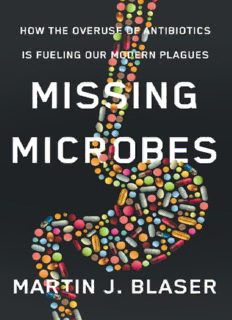
Missing Microbes: How the Overuse of Antibiotics Is Fueling Our Modern Plagues PDF
Preview Missing Microbes: How the Overuse of Antibiotics Is Fueling Our Modern Plagues
The author and publisher have provided this e-book to you for your personal use only. You may not make this e- book publicly available in any way. Copyright infringement is against the law. If you believe the copy of this e-book you are reading infringes on the author’s copyright, please notify the publisher at: us.macmillanusa.com/piracy. To my children, and to future children with a bright future CONTENTS Title Page Copyright Notice Dedication Epigraph 1. Modern Plagues 2. Our Microbial Planet 3. The Human Microbiome 4. The Rise of Pathogens 5. The Wonder Drugs 6. The Overuse of Antibiotics 7. The Modern Farmer 8. Mother and Child 9. A Forgotten World 10. Heartburn 11. Trouble Breathing 12. Taller 13. … and Fatter 14. Modern Plagues Revisited 15. Antibiotic Winter 16. Solutions Epilogue Notes Index Acknowledgments About the Author Copyright “We live in the Age of Bacteria (as it was in the beginning, is now, and ever shall be, until the world ends)…” S J G Cambridge, MA, 1993 — TEPHEN AY OULD, 13. … AND FATTER Why do antibiotics make animals bigger and fatter? The goal in our study was to re-create the weight and size increases observed in farm animals in our lab and then tease out the principles for why they occur. It took a big team to address these questions, but several scientists played key roles: Ilseung Cho, a physician and a fellow in gastroenterology; Laurie Cox, a graduate student whose dissertation project revolved around the mouse models and who at age fourteen had started working with bacteria for her father’s company, which made products for clinical bacteriology labs; and postcollege student Yael Nobel. Without such intelligent and dedicated trainees, I could not have tested any of my ideas. And there were many others who joined in the quest, from high school and college students working during the summer to college students doing independent research and visiting scholars from around the world. In 2007, after a number of attempts to get the model going, we began our first complete set of experiments on farm practices by adding four different subtherapeutic antibiotic treatments, which we called STAT, to the water bottles of mice. We only looked at females because they don’t fight as much as males, making work easier for us. The early results were not promising; there was no weight difference between the STAT and control mice. When Ilseung’s research committee was told that the mice were not gaining weight, one of our experts asked, “What’s happening to their body composition?” He was referring to the proportions of fat, muscle, and bone. We didn’t know. “Why don’t you DEXA them and find out?” he asked. DEXA them? The term refers to dual-energy X-ray absorptiometry, a test given to women to determine their bone mass and risk for osteoporosis. But DEXA also tells us how much fat is in the body and how much muscle. This suggestion turned out to be critical. We discovered that all four groups of STAT mice had about 15 percent more fat than the controls, differences that could not be explained by chance alone. We had our first evidence that antibiotics were changing metabolism, affecting body composition. The STAT mice were making more fat and had about the same amount of lean muscle as the control. We also had an unexpected finding: at seven weeks of age, three weeks following the start of the antibiotics, the mice were putting on bone at an accelerated pace. More bone formation implies that they would become bigger, longer, and taller. But by ten weeks, all the mice had similar bone mass. The effect on bone showed up early only in those that were given antibiotics. In later experiments that I describe below, we also found bone effects, some of them lifelong. Again, this was not specific to a single antibiotic. If it was, one might think of it as a side effect of that one drug. But it was present across all the antibiotics tested. This work supports the idea that, in addition to better nutrition and clean water, antibiotics may be part of the explanation of why people are taller than ever. We now had evidence that STAT changes early development but still did not understand how it happened. How did adding antibiotics to the water cause these developmental effects? What made the animals fatter and built up their bones earlier? We suspected that the drugs changed the composition of the intestinal resident microbes, so that is where we looked first by examining mouse poop. Fecal pellets represent the end product of everything that happens in the intestine and
Description: